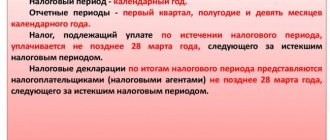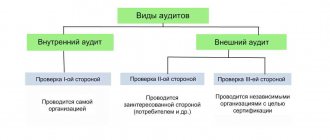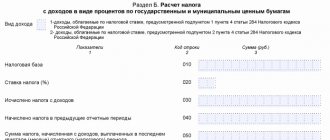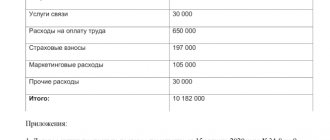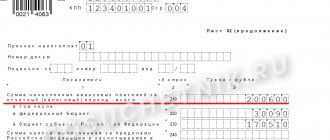Ways to check your income tax return
If the organization is correctly registered in accordance with the law of the Russian Federation, it automatically becomes a taxpayer. This means that you are required to fill out a tax return for corporate income tax.
This type of document is provided based on the results of work during the reporting period. Some rent every month, others once every six months. To make it easier for an accountant to calculate this type of tax, tax officials have come up with methodological recommendations. They help in checking declarations.
There are two stages for checking a tax return for corporate income tax:
- the first stage is characterized by the fact that it is necessary to compare the tax return data with the accountant’s report, as well as with the returns for other taxes;
- the second stage is characterized by the fact that tax authorities will deal with why the company’s profits fell, but at the same time expenses increased.
First, you need to equalize the revenue that is indicated in the income tax return with the VAT return. To do this, the values must match:
If there are discrepancies, tax officials may request that the company provide clarification. Or they will send their employee for a full check.
The next step is to check the following values:
In the case of a UST declaration, tax authorities will definitely check whether the organization justifiably removed payments to employees from expenses. Because of this, taxable profit decreases. To do this you need to check the following:
There is also an advertising tax, which the tax office will definitely check:
There will be a mandatory reconciliation with the accountant’s report, namely with forms 2 and 5 (only small institutions do not fill it out). To do this you need to compare:
It is advisable that the company does not have any discrepancies in the following operations:
If these indicators do not match, the company engages in any transactions using securities, uses market prices for exchange or non-paid transactions, also when the company’s prices are in dollars.
Tax inspectors will also analyze the following indicators:
When a company charges depreciation exactly the same in the accounting and tax statements, then the following relationship will work:
When checking a profit declaration, it is necessary to check the correctness of the values inside it. To do this, the following relationships are checked:
Checking the consistency of indicators
All data is checked for consistency both within the declaration and with other reports (both accounting and tax) of the reporting period.
This check includes analysis of data from accounting reports and tax returns to ensure compliance with the relevant control ratios. For example, when checking a corporate income tax return, sales revenue is compared with the amount of revenue reflected in the income statement. As a rule, the difference between accounting and taxable profit (loss) is formed as a result of the application of different rules for recognizing income and expenses, which are established in regulatory legal acts on accounting and tax legislation. For example, possible reasons for deviation may be: the presence of production with a long cycle, transactions with securities, gratuitous receipt of goods (work, services, property rights), revaluation of the value of property.
Attention
Small businesses (with the exception of issuers of publicly offered securities) have the right to use the cash method of recognizing income and expenses in accounting (clause 12 of PBU 9/99, clause 18 of PBU 10/99).
When combining the general tax regime and UTII, the amount of revenue in the income tax return will be less than the revenue reflected in the income statement. In letter No. 07-05-09/3 of the Ministry of Finance of Russia dated June 25, 2008, it is noted that in the income statement the amount of the single tax on imputed income is shown on a separate line (after the current income tax indicator). This is the “Other” term with code 2460.
Tax authorities will also be interested in the difference between direct expenses shown in the income tax return and the cost of sales from the income statement. In this case, the inspector may ask to submit the organization’s accounting policy, which defines a list of direct expenses.
The Federal Tax Service of Russia, in a letter dated February 24, 2011 No. KE-4-3/ [email protected] , indicated that the taxpayer has the right, for tax purposes, to classify individual costs associated with the production of goods (works, services) as indirect costs only in the absence of a real possibility include these costs in direct costs, using economically feasible indicators.
The amount of expenses associated with production and sales, as well as non-operating expenses, are compared with similar indicators reflected in the income statement (cost of sales, selling, administrative, other expenses, etc.). In this case, many deviations are also explainable. For example: the use of different methods of calculating depreciation, different assessments of inventory, the use of different rules for reflecting interest on loans received, rationing of expenses (in tax accounting), revaluation of fixed assets, formation of reserves, etc.
Please note that some indicators of accounting and tax reporting cannot be correlated. For example, paragraph 9 of Article 258 of the Tax Code of the Russian Federation allows the calculation of bonus depreciation. At the same time, such a procedure for writing off part of the cost of fixed assets is not provided for in accounting (PBU 6/01). But if the receipt of fixed assets is not traced from the accounting statements or the explanations thereto, and the depreciation bonus is declared in the declaration (lines 042 and 043 of Appendix No. 2 to sheet 02), then the inspectors will certainly have questions.
When an organization applies PBU 18/02, the difference between accounting profit (loss) and taxable profit (loss) of the reporting period is reflected in the financial statements. Deferred tax assets and deferred tax liabilities are shown in the balance sheet, respectively, as non-current assets and long-term liabilities (clause 23 of PBU 18/02). Permanent tax liabilities (assets), changes in deferred tax assets and deferred tax liabilities, current income tax are reflected in the income statement (clause 24 of PBU 18/02).
The amount of income tax on the declaration can be compared with the same indicator in the income statement. A discrepancy is possible if a distortion of the amount of income tax for previous years was revealed in the current period.
Second stage of declaration verification
In order to know how to check an income tax return, tax officials have made the work of entrepreneurs a little easier. There is a verification method.
At the second stage, an economic analysis is carried out. As a rule, this stage is carried out for reputable companies that have large profits. So small firms can calm down after the first stage.
This analysis is carried out by comparing tax and accounting reports currently and the three previous years. If violations are detected, no fines will be assessed, but an inspection will definitely come to the company.
Income tax in 1C 8.3. Step-by-step instruction
- Fill in the accounting policy settings.
- Fill out reference books related to tax registers. Pay special attention to the expense guide.
- When entering documents, correctly indicate parameters that can affect the calculation of income tax: accounts and subaccounts according to the Chart of Accounts, types of income or expenses, item groups, etc. If the documents contain special settings for tax accounting, you should pay special attention to them and, if necessary, fill out them. When entering a document, you should analyze the transactions and pay attention to the display of data in the NU.
- After entering all the documents for the month, you should generate the regulatory documents Closing the month and check the results. If the results in 1C do not coincide with the expected ones, it means that somewhere in the settings or entered documents an error was made.
- According to Kt. 68.04.1, the correct amount of income tax must be generated for the month. If you have achieved such a situation in 1C, you can go to regulatory reports and create a declaration.
- We generate and check the declaration. Sometimes you don't like the distribution of direct and indirect costs. This can be adjusted with the appropriate settings. If all the items in the declaration correspond to our expectations, we download it and send it to the tax office.
- Next, you should pay the tax and reflect the payment in 1C. Account 68.04.1 should display the real balance, reflecting the accounting for income tax on tax in terms of settlements with the tax inspectorate and budgets.
Let's look at an example of calculating tax for a quarter. The first two months of the example show options for permanent and temporary differences; in the third month we will add the purchase and sale of goods.
Fig.1 Income tax in 1C 8.3 (1-2 months)
Fig.2 Income tax in 1C 8.3 (3-4 months)
Important points to consider
Each organization must submit an income tax return, the form of which can be found in the public domain. The company itself can choose how to submit its income tax return. Its form can be different: written form, which is made in duplicate, by mail with a complete list of attachments, or electronically.
If a company does not submit a declaration on time, a fine of 1,000 rubles will be imposed. when paying tax but not submitting an annual report; if the company has not paid the tax - 5% of its amount, but not less than 1,000 rubles.
When a company’s indicators do not match, the tax officials themselves indicate in their methodological materials that this may be due to a change in production technology. But in order not to look for any loopholes, try to fill out the declaration correctly so as not to have to check it later.
Theory and practice
The norms of the Tax Code are becoming more and more unambiguous, and expenses are becoming clearer, you just need to justify them.
The method of preliminary determination of the tax result outlined in the article allows any manager not to wait with horror on the 20th and 28th days of the month after the end of the period, thinking how many fees will have to be paid to the budget. Now you can predict your tax budget for VAT and income tax. And be careful with optimization!
Dmitry Vasiliev
–
expert of the magazine "Raschet"
Organizational issues of conducting PNC.
On the basis of what data is the KNI of the income tax return carried out and what period is subject to verification?
The definition of KNI and the procedure for its implementation are set out in Art. 88 Tax Code of the Russian Federation.
According to paragraph 1 of this article, KNI is carried out at the location of the tax authority on the basis of:
- tax returns (calculations);
- documents submitted by the taxpayer[1];
- other documents on the activities of the taxpayer available to the tax authority.
As a general rule, the tax authority does not have the right to carry out tax inspection without a declaration based on other documents. If there is no declaration, then other forms of tax control must be used (Resolution of the Presidium of the Supreme Arbitration Court of the Russian Federation dated June 26, 2007 No. 2662/07 in case No. A19-5641/06-10).
However, there is an exception to this rule: if a declaration (calculation) is not submitted to the tax authority within the prescribed period by the taxpayer - the controlling person of the organization, recognized as such in accordance with Chapter. 3.4 of the Tax Code of the Russian Federation, the tax authority has the right to conduct a tax inspection on the basis of the documents (information) it has about the taxpayer, as well as data about other similar taxpayers within three months from the date of expiration of the established deadline for submitting such a declaration (calculation).
By virtue of clause 2 of Art. 88 of the Tax Code of the Russian Federation, a “camera room” on income tax is carried out by tax inspectors without any special decision[2] of the head of the tax authority.
CNI for income tax is carried out for the reporting (tax) period specified in the declaration.
According to Art. 285 of the Tax Code of the Russian Federation, the tax period for income tax is the calendar year (clause 1). Tax reporting periods are the first quarter, six months and nine months of the calendar year, and for taxpayers who calculate monthly advance payments based on the actual profit received - a month, two months, three months, etc. until the end of the calendar year (clause 2 ).
In what time frame must the income tax return be processed?
In accordance with clause 2, 10 art. 88 of the Tax Code of the Russian Federation, a “camera meeting” on income tax is carried out within three months from the date the taxpayer (or tax agent) submits a tax return (calculation), unless otherwise provided by this paragraph.
According to Art. 6.1 of the Tax Code of the Russian Federation, the period begins on the next day after the calendar date or the occurrence of an event (action) that determines its beginning (clause 2). A period calculated in months expires on the corresponding month and day of the last month of the term. If the end of the period falls on a month in which there is no corresponding date, then the period expires on the last day of that month (clause 5).
Please note that if the declaration is submitted by mail, the day it is sent and the day it is received by the inspection do not coincide. In this case, the period must be counted from the date of receipt of the declaration by the Federal Tax Service (see letters of the Ministry of Finance of Russia dated December 22, 2017 No. 03-02-07/1/85955, Federal Tax Service of Russia dated July 16, 2013 No. AS-4-2/12705 (clause 2.2 )).
Let’s assume that the Federal Tax Service received an income tax return for the nine months of 2021 on 10/25/2019. Three months expire on 01/25/2020. Since it is Saturday, the check deadline is 01/27/2020.
So, the period for conducting the CNI is three months. This period cannot be extended or suspended.
Moreover, if before the end of the tax return the taxpayer submits an updated declaration (calculation), the tax return of the previously submitted declaration (calculation) is terminated and a new tax return begins based on the “clarification”. Termination of the tax return means the termination of all actions of the tax authority in relation to the previously submitted declaration (calculation). At the same time, documents (information) received by the tax authority within the framework of the terminated tax compliance process can be used when carrying out tax control measures in relation to the taxpayer (clause 9.1 of article 88 of the Tax Code of the Russian Federation).
note
According to the Ministry of Finance, violation of procedural deadlines during tax control activities is not a significant violation entailing the unconditional cancellation of the tax authority’s decision made based on the results of a tax audit (Letter No. 03-02-07/1/18400 dated March 23, 2018).
In what cases does the tax authority have the right to require the taxpayer to provide the necessary explanations?
These cases are listed in paragraph 3 of Art. 88 Tax Code of the Russian Federation.
During the KNI in relation to the income tax return, the following may be identified:
- errors in the tax return and (or) contradictions between the information contained in the submitted documents;
- discrepancies between the information provided by the taxpayer and the information contained in the documents available to the tax authority and received by it during tax control.
The taxpayer is informed about this with the requirement to provide the necessary explanations within five days or make appropriate corrections within the prescribed period.
In addition, within five days you must submit:
- when conducting a tax return inspection on the basis of an updated income tax declaration, in which the amount of tax payable to the budget is reduced compared to the previously submitted declaration, explanations justifying the change in the relevant indicators of the tax declaration;
- when conducting a tax return on income tax, which states the amount of loss received in the corresponding reporting (tax) period, - explanations justifying the amount of loss received.
note
Paragraph 4, paragraph 3, art. 88 of the Tax Code of the Russian Federation establishes that taxpayers who are obligated to submit a VAT return in electronic form, when conducting the CNI of such a declaration, provide explanations in electronic form according to the TKS (if explanations are submitted on paper, they are not considered submitted).
Based on the clarifications of the Ministry of Finance (Letter dated July 22, 2019 No. 03‑02‑08/54231), since the Tax Code of the Russian Federation does not limit taxpayers in choosing the method of submitting explanations to tax returns for other taxes (including tax audit for income tax), such explanations can be submitted to the tax authorities both on paper and in electronic form.
Clause 4 of Art. 88 of the Tax Code of the Russian Federation provides that a taxpayer who submits the above-mentioned explanations to the tax authority has the right to additionally submit extracts from tax and (or) accounting registers and (or) other documents confirming the accuracy of the data included in the tax return.
Documentary grounds for income tax control
The main document used by the office inspector is the declaration. If during the inspection the inspector finds errors or inconsistencies in the indicators, the taxpayer is asked to provide explanations and documentary evidence of the declaration indicators (clause 3 of Article 88 of the Tax Code of the Russian Federation).
In addition to the data provided by the taxpayer, the inspector may use:
- Documentary materials presented during previously conducted inspections.
- Information received from other institutions - foundations, law enforcement agencies.
- Data from the initially conducted desk audit when monitoring the indicators of the updated declaration.
- Evidence received from third parties.
In order to obtain the most complete information, the inspector has the right, in order to exchange information with institutions, to receive documents upon request.
